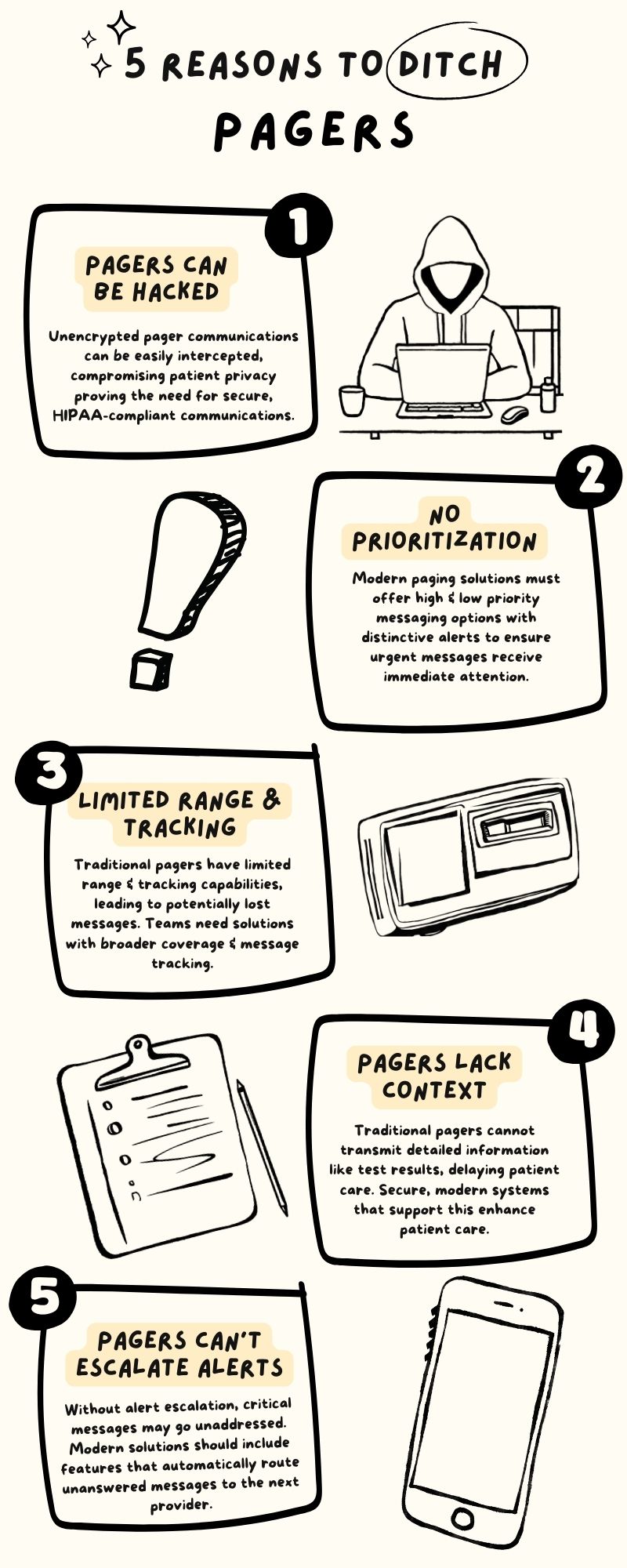5 Reasons to Ditch Pagers
Healthcare professionals are often unaware of the potential dangers that pagers pose for clinical communication. When communicating through pagers, doctors are subject to delivering limited, non-descriptive messages to maintain HIPAA compliance due to their unencrypted, legacy capabilities. This not only creates concerns for cybersecurity, but can also reduce the effectiveness of a care team’s communication and collaboration, which can in turn reduce patient care quality.
However, now there are healthcare technologies on the market that ensure HIPAA compliance and don’t limit a doctor’s ability to communicate effectively, so I started wondering – why do doctors still use pagers? In this article I will explore 5 reasons to ditch pagers and discuss why healthcare professionals should consider switching to more advanced clinical communication and collaboration solutions.
Before we get started evaluating all of the reasons why pagers suck, I wanted to remind you of the HIPAA regulations that all provider-to-provider digital communications are required to meet (pagers meet none of these requirements)…
- A sign-in process
- An encrypted messaging process
- Remote wipe capabilities
Key Takeaways
- Unencrypted pager communications can be easily intercepted, compromising patient privacy, proving the need for investments in secure, HIPAA-compliant communications.
- Modern paging solutions must offer high and low priority messaging options with distinctive alerts to ensure urgent messages receive immediate attention.
- Traditional pagers have limited range and tracking capabilities, leading to potentially lost messages. Teams need solutions with broader coverage and message tracking.
- Traditional pagers cannot transmit detailed information like test results or imaging, delaying patient care. Secure, modern systems often support this and improve care.
- Without alert escalation, critical messages may go unaddressed. Modern solutions should automatically route unanswered messages to the next available provider.
1. Pagers Can Be Hacked
As I previously stated, pagers are unencrypted, meaning that if a hacker intercepts pager communications, they can see and read all the messages being exchanged. So, if a doctor is not strictly following the guidelines, sensitive patient information can be compromised, putting their privacy at risk.
A recent example is when Providence Health & Services was the target of a prominent hack of its paging system. Due to this breach, the hospital had to register the violation with the Department of Health and Human Services. But, even after registering, the consequences of the breach didn’t stop. The hospital had to swiftly invest in new technology to ensure that its patient information process reached an adequate level of HIPAA compliance.
This recent cybersecurity incident proves the need for healthcare teams to advance their processes before it’s too late. There are many clinical communication and collaboration solutions to choose from that provide HIPAA secure, encrypted messaging that will enable teams to deliver more contextual information during time-sensitive events without the fear of a breach.
Try OnPage for FREE! Request an enterprise free trial.
2. No Prioritization Capabilities
In a world where doctors get bombarded with alerts and notifications for anything under the sun, it is essential to differentiate which alerts are important and which alerts can be dealt with later. For this very reason, modern paging solutions need to enable the user to send two types of messages:
- High Priority
- Low Priority
Alternative solutions need to differentiate between these two priority modes with unique ringtones, and persistently alert the message recipient when the issue is of great severity.

High-priority messaging requires an intrusive, distinctive ringtone that always gets the provider’s attention. Basically, the alert needs to mimic the urgency of a pager, right from the care provider’s mobile device.
Low-priority messaging can be used for chat-based messaging – sending and receiving messages in a single continuous conversation. However, unlike pagers and other casual messaging apps, modern paging solutions should enable the provider to track all of the messages that are being sent even when they are low-priority.
3. Limited Range and Tracking Capabilities
Outside of a few square blocks neighboring a hospital, a pager often won’t receive its intended page. So, if an on-call doctor or nurse were to head home or elsewhere during an on-call shift, they may not receive a page, and once the page is lost there is no way to retrieve or track it.
This means the page is lost forever.
Legacy pager communications rely on paging towers to deliver messages. Yet, as pager usage decreases, so does the maintenance of paging towers. Considering this, care teams must invest in solutions with wider coverage and better support that ensure all messages are received and trackable.
4. Pagers Lack Contextual Communication
To effectively diagnose and provide treatment to a patient, care providers need to quickly obtain test results and imaging. Unfortunately, traditional pagers are incapable of transmitting this necessary level of information. Instead, healthcare providers are left with the little information they see on the pager screen, forcing them to seek out further information and answers, significantly delaying patient care.
When replacing paging systems, teams should choose a system that can not only deliver secure text messages, but secure attachments as well. With traditional communication methods like email or SMS, there is no guarantee that attachments are encrypted. So, by investing in a clinical communication and collaboration solution that supports secure attachment delivery providers can speed up care delivery and ensure that they can make more informed decisions on the spot.
5. Pagers Cannot Escalate Alerts
In the event where a care provider cannot answer a page, there is not much that can be done with a pager alone. As a result, critical alerts can go unaddressed, preventing a patient from receiving the prompt care they need.
When evaluating paging systems it’s important to consider alert escalation features.
Alert escalation features ensure that critical messages that are not addressed within a predetermined period of time are always automatically routed to the next provider on the on-call team.
Try OnPage for FREE! Request an enterprise free trial.
How are Industries Replacing Pagers?
As technology modernizes and cybercriminals get smarter, there is no good reason for teams to stick to legacy pager communications. But, the question stands, how can healthcare teams replace their current paging systems?
The answer is simple.
With a secure clinical communication and collaboration solution, like OnPage, that ensures that teams can overcome all of the challenges listed in this article, teams can successfully replace their pagers.
OnPage delivers loud, distinguishable alerts in the case of urgent patient needs that mimic the intrusiveness of pagers on the provider’s smartphone. This enables teams to keep all of the things they like about pager communications while eliminating the even longer list of things that they don’t.
Considering the increased need for modern tools care teams must ask themselves…how can we successfully build the best clinical communication and collaboration plan?


